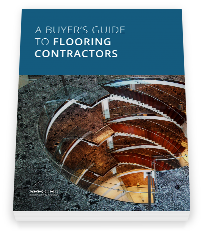Acoustic flooring: What you need to consider when selecting a material
Sound treatment is a key design consideration for almost every building, regardless of industry, in order to reduce noise disturbance and enhance sound quality. And selecting acoustic flooring materials is crucial to effective sound treatment.
When noise is made within your building, it will either be absorbed, reflected or transmitted by your wall, ceiling and flooring. The goal of sound treatment is twofold: (1) prevent transmission of sound from room to room and floor to floor, and (2) reduce background noise to enhance the quality of speech or music within rooms. Installing acoustic flooring is an effective and efficient way of accomplishing the former goal.
While acoustic ceiling and wall treatments protect against transmission of sound from room to room, acoustic flooring is effective at preventing the transmission of sound from an upper floor to a lower floor. Together with ceiling and wall coverings, your acoustic flooring system will help create the best acoustic environment for your building’s application.
Types of noise acoustic flooring can help with
In general, acoustic flooring must prevent the transmission of two types of noise:
-
Impact sound
Whether from foot traffic, carts or vibrating machinery, floors bear the brunt of impact within your building. The sound energy generated by this impact can be transmitted through the structure of your building, distorting noise and disturbing workers, guests or residents. Acoustic flooring is designed to insulate impact noise, preventing its transmission from your flooring into the rooms below.

A flooring material’s effectiveness at preventing the transmission of impact noise is measured by its impact insulation class (ICC). The higher a flooring’s ICC, the more impact sound insulation it provides.
A material’s ICC rating is measured using a “hammer machine” on an upper floor, and measuring the sound in decibels in the room below. Floating floors, carpet pads and sound-insulating underlayment can greatly improve a flooring system’s ICC rating.
-
Airborne sound
Airborne sound typically stems from people, speakers and instruments. Like impact sound, airborne sound can transmit through your flooring into other parts of your building.
A material’s ability to prevent the transmittance of airborne sound is measured using a different metric—sound transmission class (STC). An STC rating is a logarithmic measure of a sound’s transmission loss between two rooms, measured across 16 frequencies from 125 Hz to 5000 Hz. Essentially, a material’s STC rating measures its ability to absorb airborne noise and, consequently, prevent its transmission.
Acoustic flooring options: 5 materials suited for sound treatment
Both metrics are important in comparing acoustic flooring materials, and choosing the underlayment and final flooring that best fit your building’s particular application. Still, a material’s acoustic qualities are not the only factor to consider when selecting a flooring material for your building.
For example, while carpeting might work perfectly within a classroom, it wouldn’t meet the sanitary standards to be used in an operating room. There are many factors to consider beyond acoustics—and a flooring contractor can guide you through them all.
While acoustic flooring materials are not one-size-fits-all, there are some materials that are better at preventing sound transmission than others.
Here are some of the best acoustic flooring materials:
-
Carpet
Carpet is known for mitigating impact sound, making it a perfect choice for hotels, classrooms and offices. Higher pile carpets or carpets with a thick pad underneath, are especially good at absorbing sound and reducing transmission. Read our buyer’s guide to commercial carpets now.

Selecting carpet for your budget, interior design and facility environment
Selecting a carpet that matches your design vision, stands up to your facility environment and aligns with your budget is no small task. We’ve created this guide as a resource to help you make an informed carpet purchasing decision.
-
Cork flooring
Cork flooring is a sustainable, comfortable and sound-absorbent flooring option perfect for many commercial applications. Still, due to its tendency to stain and indent it is often used as an underlay to provide acoustic insulation. Read more about cork flooring here.
-
Wood Plastic Composite (WPC) flooring
Durable, waterproof and easy to maintain, WPC flooring provides great acoustic benefits, especially when it comes to mitigating the impact noise such as high foot traffic. Its acoustic benefits are largely drawn from its backing layer, which not only provides sound insulation, but also protects against mold and mildew. Learn more about WPC flooring here.
-
Rubber flooring
Commercial rubber flooring is known for its sound absorbent qualities. More than that, it is slip-, mold- and mildew-resistant. It is a great choice for hospitals, schools, gyms and kitchens looking for a durable acoustic flooring material. Read more about rubber flooring here.
-
Vinyl tile
Vinyl tile, especially luxury vinyl tile (LVT) installed with a sound-insulating underlayment, is a great resilient flooring option used for sound treatment. It is selected by many facilities due to its design versatility, durability and relatively low maintenance costs. Learn more about commercial LVT flooring here.
One flooring material does not fit all. And a material’s acoustic quality should not be the only factor you use when selecting flooring for your facility. A flooring contractor can walk you through all the factors you need to consider so you can choose the material that makes the most sense for your building’s specific needs, while taking your budget into consideration.
Learn more about the benefits of partnering with an experienced commercial flooring contractor by reading our Buyer’s Guide to Flooring Contractors. Fill out the form below to download it for free.

A buyer’s guide to commercial flooring
How to get the greatest-value floor and select the right contractor for your project.
